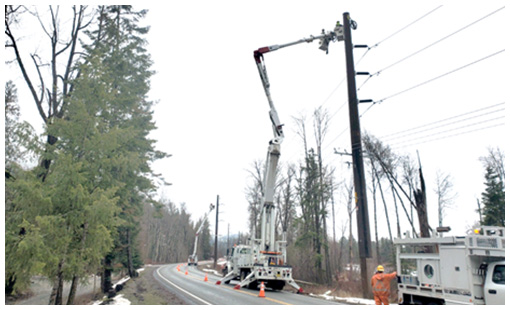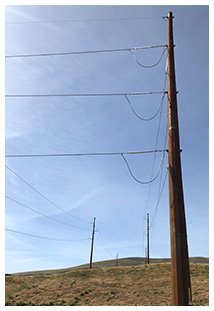Bluebird-Garden Springs 230 kV West Plains Transmission Line Project
Avista owns and operates a system of over 2,200 miles of electric transmission facilities. To plan for the future, we forecast how much power we will need to serve all our customers and how that power will get there safely and reliably. Sometimes that means extending our transmission facilities and lines.

The West Plains area is located west of the City of Spokane consisting of the City of Airway Heights, Medical Lake, City of Cheney, Fairchild Air Force Base, and the Spokane International Airport. Avista is the only Transmission Service Provider in the area.
The transmission system in the West Plains area has several constraints due to lack of necessary transmission infrastructure serving the existing area and its future growth.
The Bluebird to Garden Springs 230 kV West Plains Transmission Line Project is part of an overall effort to increase the capacity and reliability of Avista’s 230 kV transmission system. The bulk of Avista’s 230 kV transmission system was constructed in the late 1950’s and 1960’s after the completion of Cabinet Gorge and Noxon Rapids Dams located on the Clark Fork River.
Project Benefits
Through projects like this, Avista will be able to bring more power into the area. Other advantages include:
- Increased reliability for customers. Including electric utilities not owned by Avista
- Increased flexibility to deliver energy and reserve capacity.
- Provide a back-up resource to shift electrical loads when there is an outage or equipment failure, which will help restore power more quickly.
- Provide the capacity to respond to future growth and energy demands.
About the Project
The West Plains area is quickly growing thanks to efforts from various groups, including government, tribal, public, and private entities. They have invested a lot of time and money to support this growth and are working on building the necessary infrastructure. Avista is joining this effort by strengthening the electric grid to support recent growth and future development.

Constructing a new 230kV Transmission line is one piece of a larger reinforcement plan in the West Plains. This transmission line will connect our future Bluebird substation to our future Garden Springs substation.
- Length: Approximately 13 miles
- Poles: Single poles made of self-weathering steel with a reddish-brown finish
- Height: Poles will be 80 to 130 feet tall above the ground line
- Diameter: Poles will range from 2 to 7 feet in diameter, with most being 3-5 feet in diameter at the ground line
- Cables: Four cables will be carried, including three 230kV conductors and one optical ground wire for communication
The area between Bluebird Substation and Garden Springs Substation has diverse terrain—urban, forests, wetlands, and farmland. Most of the land is privately owned. There has been an extensive public process to determine the new route for this project. At this time, all affected property owners have been notified of the need for an easement on their property.
The Transmission portion of this project includes four phases:
- Two open house workshops were held in September 2023 to gather community feedback on routing options.
- Using this feedback, our consultant conducted extensive analysis to determine the route across the West Plains.
- Our Transmission Engineer and Real Estate Representative are working with property owners individually to adjust the route across their properties whenever possible.
Our Transmission Engineer is designing the transmission line along the determined route, collaborating with property owners to address their concerns and make adjustments as needed.
- Our Real Estate Representative will personally contact property owners to discuss the proposed easement on their property and address any questions they may have. For more details on Easement Acquisition, please refer to the FAQ section below.
- Our environmental team is conducting in-depth studies to identify environmental impacts throughout the project's life, in compliance with the State Environmental Policy Act (SEPA). This includes wetland and historical/cultural studies.
Construction begins with vegetation removal within our easement, followed by mobilization of equipment, access road and foundation construction, pole installation, and finally, line construction.
What to Expect
While most of our work will be on private property, Avista will implement traffic control measures during construction to minimize any impact on you and your neighbors. Work along the route may happen intermittently, and construction activities in a specific area might not be completed all at once. There will be multiple construction sites and activities happening simultaneously, with work hours, traffic control, and noise restrictions set by local authorities.
If the transmission line or an access road is on your property, you can expect to see Avista personnel and contractors on-site at various times throughout the project.
Project Schedule and Map
- Q3 2023-Q2 2024: Line Siting
- Q4 2023-Q4 2024: Line Design
- Q2 2024-Q1 2025: Easement Acquisition
- Q4 2024-Q3 2025: Permitting/Environmental Studies
- Q2 2026-Q1 2027: Construction

FAQs
As the area we live in continues to grow, the need for electricity increases as well. Since generation facilities are not typically located in urban or residential communities, transmission lines are needed to carry electricity from the distant generating facilities to urban areas. To do this economically, transmission lines operate at very high voltages. These voltages can range from 69,000 to 500,000 volts. Avista primarily operates two types of transmission lines - 115,000-volt (115kV) and 230,000-volt (230kV). When Avista builds a transmission line, we need access to the land we cross. To acquire this access, we will sometimes buy the land we need and become the fee owners of that land. More often, however, we purchase the rights to use the land in a specific way.
When Avista builds a transmission line, we need access to the land we cross. To acquire this access, we will sometimes buy the land we need and become the fee owners of that land. More often, however, we purchase the rights to use the land in a specific way. An easement grants a property owner or entity the right to use another owner's land for a specific purpose. While the easement holder has a legal interest in the property for that use, they do not own the land. Easements are typically permanent and are often established for purposes like access, utilities, and trails.
When needed, we install electric and natural gas infrastructure on private land. An easement ensures our long-term access to the property, allowing us to operate our facilities, manage vegetation, and make future system upgrades to maintain power and natural gas services for our customers.
We may place facilities on or near your property. Occasionally, our crews will need to access these facilities or manage vegetation on or from your property. We will take reasonable measures to minimize any disruption to your use of the property and will restore any areas affected by our activities.
Buildings: The construction of dwellings and other permanent structures within the Easement is not permitted; however, non-permanent storage sheds that meet clearance requirements are generally allowed. Any structures, dwelling or otherwise, built near powerlines must meet National Electric Safety Code (NESC) clearance requirements. Please review all plans with Avista's Transmission Line Design department to ensure proper clearances are maintained.
Landscaping: Landscaping on Avista easements is permitted under specific conditions. All landscape plantings are limited to species that mature at a height of fifteen feet or less. In most cases trees interfere with our structures, lines, or access roads and therefore, we usually do not allow trees or shrubs in the easement. We do, however, allow gardens, Christmas trees and other slow growing trees and shrubs that grow to a mature height not exceeding fifteen feet.
An Avista Real Estate Representative will be available to you throughout the entire process. The steps typically include:
- Initial contact from us
- Requesting permission to survey/access property
- Discussing with you the preferred placement of potential structures on your property
- Presenting an easement offer package based on fair market value for your consideration
- Discussing the easement package with an Avista Real Estate Representative
- Signing the easement documents in the presence of a notary public
- Receiving payment for the easement
- The Avista Real Estate Representative will record easement documents with the Local jurisdiction
- The Avista Real Estate Representative will provide a copy of the recorded easement documents
We assure you that we will collaborate with you in good faith, uphold ethical standards, and provide fair compensation for the use of your property.
Our system upgrades benefit the public by ensuring access to safe, affordable, and reliable energy. In rare cases where a property owner does not grant an easement, Avista, acting in the public interest, may use its right of eminent domain to an easement over private property, for public use. This legal process allows a court to grant Avista the necessary rights while also determining fair compensation for the property owner.
For inquiries about this project, you can contact us at WestPlains230kV@avistacorp.com.

